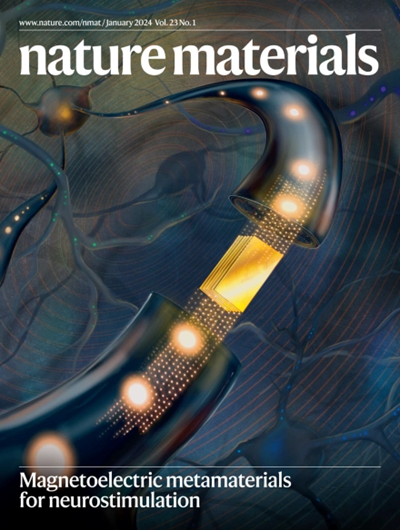通过可编程键的逆设计编码分层三维结构
IF 38.5
1区 材料科学
Q1 CHEMISTRY, PHYSICAL
引用次数: 0
摘要
通过设计在小尺度上制造材料和设备的能力导致了巨大的技术进步。然而,对工程三维纳米材料的需求需要新的策略来组织纳米组件。在这里,我们展示了一种逆向设计方法,用于使用具有定向,可寻址键的DNA体素将纳米颗粒组装成分层有序的3D组织。通过识别重复中尺度结构图案的内在对称性,我们规定了一组体素,称为中尺度体素,它们被组装成目标3D晶体。采用实验和计算方法研究了体素键不同程度的编码信息与装配保真度之间的关系。我们应用这种组装策略来创建周期性的三维纳米粒子有序组织,包括具有低维元素的结构,螺旋图案,面心钙钛矿晶体的纳米级模拟物以及基于具有等离子体和光子长度尺度制度的晶体的分布式布拉格反射器。本文章由计算机程序翻译,如有差异,请以英文原文为准。


Encoding hierarchical 3D architecture through inverse design of programmable bonds
The ability to fabricate materials and devices at small scales by design has resulted in tremendous technological progress. However, the need for engineered three-dimensional (3D) nanoscale materials requires new strategies for organizing nanocomponents. Here we demonstrate an inverse design approach for the assembly of nanoparticles into hierarchically ordered 3D organizations using DNA voxels with directional, addressable bonds. By identifying intrinsic symmetries in repeating mesoscale structural motifs, we prescribe a set of voxels, termed a mesovoxel, that are assembled into target 3D crystals. The relationship between different degrees of encoded information used for voxel bonds and the fidelity of assembly is investigated using experimental and computational methods. We apply this assembly strategy to create periodic 3D nanoparticle ordered organizations, including structures with low-dimensional elements, helical motifs, a nanoscale analogue of a face-centred perovskite crystal and a distributed Bragg reflector based on a crystal with plasmonic and photonic length-scale regimes. An inverse design strategy is reported for the organization of nanoscale matter using DNA-programmable bonds and the fabrication of hierarchically ordered 3D assemblies.
求助全文
通过发布文献求助,成功后即可免费获取论文全文。
去求助
来源期刊

Nature Materials
工程技术-材料科学:综合
CiteScore
62.20
自引率
0.70%
发文量
221
审稿时长
3.2 months
期刊介绍:
Nature Materials is a monthly multi-disciplinary journal aimed at bringing together cutting-edge research across the entire spectrum of materials science and engineering. It covers all applied and fundamental aspects of the synthesis/processing, structure/composition, properties, and performance of materials. The journal recognizes that materials research has an increasing impact on classical disciplines such as physics, chemistry, and biology.
Additionally, Nature Materials provides a forum for the development of a common identity among materials scientists and encourages interdisciplinary collaboration. It takes an integrated and balanced approach to all areas of materials research, fostering the exchange of ideas between scientists involved in different disciplines.
Nature Materials is an invaluable resource for scientists in academia and industry who are active in discovering and developing materials and materials-related concepts. It offers engaging and informative papers of exceptional significance and quality, with the aim of influencing the development of society in the future.
 求助内容:
求助内容: 应助结果提醒方式:
应助结果提醒方式:


